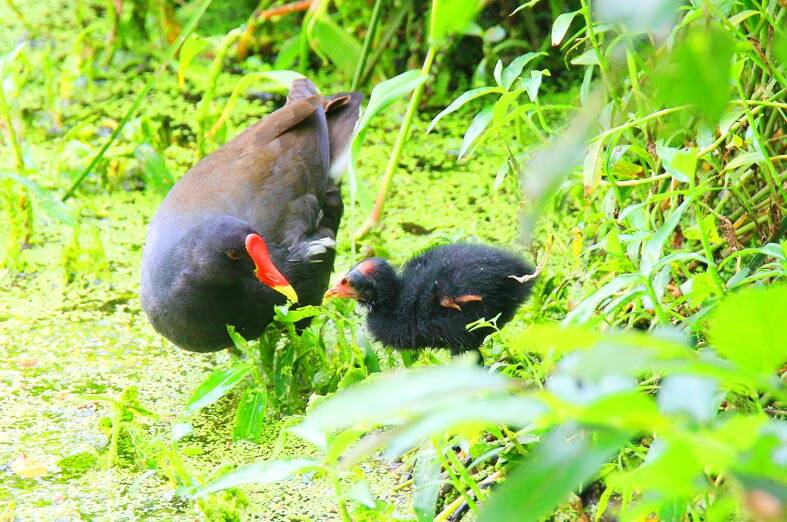The Taiwan Wild Bird Federation and the Taiwan Biodiversity Research Institute yesterday invited bird-watchers from across the nation to help complete the Taiwan Bird Atlas by 2028 after the project was officially launched in January.
The project is a collaboration between the two bodies and Ithaca, New York-based Cornell Lab of Ornithology, the federation said in a statement.
Similar initiatives have been launched in 93 countries, involving more than 600 projects and the participation of at least 380,000 people as of 2021, the statement said.

Photo courtesy of Taiwan Wild Bird Federation
Bird atlases are crucial for documenting and conserving biodiversity, it said.
“The goal is to complete detailed maps outlining the distribution, breeding and number of bird species across Taiwan by 2028,” it said.
Prior to the official launch of the atlas project this year, the federation and the institute jointly launched the eBird Taiwan portal — modeled after and hosted on an online platform developed by the Cornell laboratory and the New York-based National Audubon Society — in 2015, the statement said.
It has since become Taiwan’s largest open source of biodiversity data, with more than 12 million records as of last year, it said.
“Additionally, the institute has developed SILIC [Sound Identification and Labeling Intelligence for Creatures], an artificial-intelligence tool that identifies birds based on the sounds they make,” it said. “The atlas project will build on these foundations.”
Federation secretary-general Lu Yi-wei (呂翊維) said that people who want to participate in the project can visit the online Taiwan Bird Atlas portal at https://ebird.org/atlastw or join the eBird Taiwan group on Facebook.
Participants are expected to conduct observations in units of 5km2, Lu said, adding that they must accumulate at least 20 hours of observations in each grid within five years.
“They should try their best to visit major habitats and use the eBird database to record as much about the species and quantities of birds they see,” he said.
“Unlike general bird-watching activities, users must go one step further to observe and record the breeding behaviors of birds, such as pair activity, nest building, or carrying food to raise chicks,” he added.
The Bird Atlas is crucial for recording and conserving biodiversity and requires a considerable amount of data, Lu said, adding that engaging the public in data collection is the best way to obtain a lot of information and accurately map the distribution of bird species.

TRAGEDY STRIKES TAIPEI: The suspect died after falling off a building after he threw smoke grenades into Taipei Main Station and went on a killing spree in Zhongshan A 27-year-old suspect allegedly threw smoke grenades in Taipei Main Station and then proceeded to Zhongshan MRT Station in a random killing spree that resulted in the death of the suspect and two other civilians, and seven injured, including one in critical condition, as of press time last night. The suspect, identified as a man surnamed Chang Wen (張文), allegedly began the attack at Taipei Main Station, the Taipei Fire Department said, adding that it received a report at 5:24pm that smoke grenades had been thrown in the station. One man in his 50s was rushed to hospital after a cardiac arrest

A car bomb killed a senior Russian general in southern Moscow yesterday morning, the latest high-profile army figure to be blown up in a blast that came just hours after Russian and Ukrainian delegates held separate talks in Miami on a plan to end the war. Kyiv has not commented on the incident, but Russian investigators said they were probing whether the blast was “linked” to “Ukrainian special forces.” The attack was similar to other assassinations of generals and pro-war figures that have either been claimed, or are widely believed to have been orchestrated, by Ukraine. Russian Lieutenant General Fanil Sarvarov, 56, head

SAFETY FIRST: Double the number of police were deployed at the Taipei Marathon, while other cities released plans to bolster public event safety Authorities across Taiwan have stepped up security measures ahead of Christmas and New Year events, following a knife and smoke bomb attack in Taipei on Friday that left four people dead and 11 injured. In a bid to prevent potential copycat incidents, police deployments have been expanded for large gatherings, transport hubs, and other crowded public spaces, according to official statements from police and city authorities. Taipei Mayor Chiang Wan-an (蔣萬安) said the city has “comprehensively raised security readiness” in crowded areas, increased police deployments with armed officers, and intensified patrols during weekends and nighttime hours. For large-scale events, security checkpoints and explosives

PUBLIC SAFETY: The premier said that security would be tightened in transport hubs, while President Lai commended the public for their bravery The government is to deploy more police, including rapid response units, in crowded public areas to ensure a swift response to any threats, President William Lai (賴清德) said yesterday after a knife attack killed three people and injured 11 in Taipei the previous day. Lai made the remarks following a briefing by the National Police Agency on the progress of the investigation, saying that the attack underscored the importance of cooperation in public security between the central and local governments. The attack unfolded in the early evening on Friday around Taipei Main Station’s M7 exit and later near the Taipei MRT’s Zhongshan